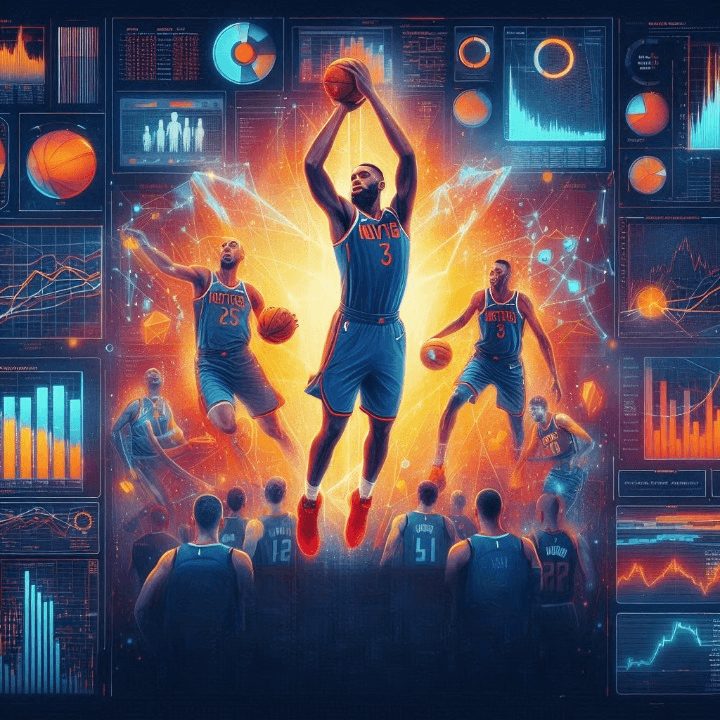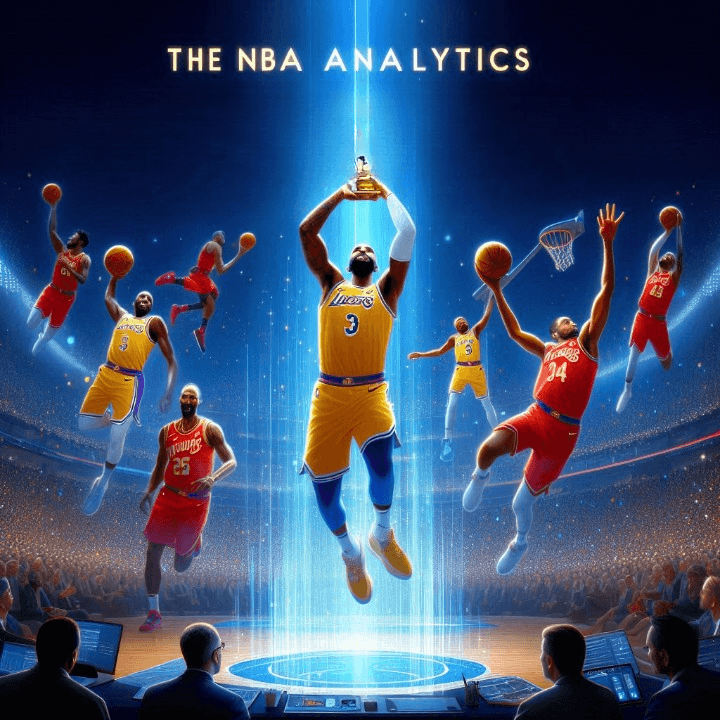The National Basketball Association (NBA) has long been at the forefront of sports innovation, constantly pushing the boundaries of what’s possible on and off the court. In recent years, however, a new revolution has taken the league by storm – the NBA analytics revolution. This data-driven transformation is fundamentally changing the way teams approach the game, from player evaluation and roster construction to in-game strategy and player development.
The Rise of Analytics in the NBA
The use of data and analytics in professional sports is not a new concept, but the NBA has emerged as a true leader in this field. In the early 2000s, a handful of pioneering teams and executives began to recognize the potential of using advanced statistics and data analysis to gain a competitive edge. Figures like Daryl Morey, the former general manager of the Houston Rockets, and Mike D’Antoni, the innovative head coach, were among the early adopters who championed the use of analytics in the NBA.
As the league’s analytical capabilities grew, so did the depth and sophistication of the data being collected. From traditional box score statistics to advanced metrics like true shooting percentage, player efficiency rating (PER), and win shares, the NBA’s data ecosystem has become increasingly complex and nuanced. This explosion of data has given teams a wealth of information to draw from, enabling them to make more informed decisions and develop more effective strategies.
Player Evaluation and Roster Construction
One of the most significant impacts of the NBA analytics revolution has been on player evaluation and roster construction. Teams are no longer relying solely on the traditional scouting methods of the past, which often prioritized physical attributes and subjective assessments of a player’s potential.
Instead, front offices are using advanced metrics and data-driven models to identify the key drivers of player value and build rosters that maximize their resources. By analyzing a player’s statistical profile, advanced analytics can provide a more holistic understanding of their skills, tendencies, and overall contribution to the team.
This data-driven approach has enabled teams to uncover hidden gems, identify undervalued players, and assemble roster compositions that are better aligned with the modern NBA game. For example, the rise of the “three-and-D” archetype, where players who excel at three-point shooting and defensive intensity are highly sought after, is a direct result of the analytics-driven shift in roster construction.
In-Game Strategy and Decision-Making
The impact of analytics on the NBA game extends beyond roster construction and player evaluation – it’s also transforming the way teams approach in-game strategy and decision-making.
Gone are the days of relying solely on intuition and traditional coaching philosophies. Coaches and teams are now leveraging data-driven insights to make more informed, strategic choices during the game. This includes everything from shot selection and defensive schemes to substitution patterns and end-of-game scenarios.
One of the most prominent examples of this analytical shift is the dramatic increase in three-point shooting across the league. Teams have recognized the value of the three-point shot, which is more efficient than mid-range jumpers and layups, and have adjusted their offensive strategies accordingly. Analytics have helped teams identify the optimal shot locations, player combinations, and offensive systems to maximize their three-point output.
In addition, teams are using data to inform their defensive strategies, identifying the most effective ways to neutralize the opposing team’s strengths and exploit their weaknesses. This has led to the rise of innovative defensive schemes, such as the “switching” defense, where players switch assignments on screens to create more favorable matchups.


Player Development and Injury Prevention
The NBA analytics revolution has also had a significant impact on player development and injury prevention. Teams are now using data-driven insights to optimize their training regimes, rehabilitation programs, and overall player management strategies.
By analyzing biometric data, performance metrics, and injury histories, teams can develop customized training plans and recovery protocols tailored to the unique needs of each player. This has enabled teams to not only improve player performance but also reduce the risk of injuries, which can be devastating to a team’s success.
Moreover, teams are using advanced analytics to identify patterns and risk factors associated with specific types of injuries. This knowledge allows them to proactively implement prevention strategies, such as targeted strengthening exercises or adjustments to playing time and rest periods.
The Impact on the Fan Experience
The NBA analytics revolution is not only transforming the game on the court but also the fan experience off it. Teams are leveraging data and analytics to enhance the ways in which they engage with their fan base, from in-arena experiences to digital content and fan-facing applications.
One of the most visible examples of this is the integration of advanced statistics and data visualizations into game broadcasts and team-produced content. Fans are now able to access a wealth of real-time data and insights that provide a deeper understanding of the game, from player and team performance to game strategy and decision-making.
Additionally, teams are using analytics to personalize the fan experience, tailoring ticket offerings, merchandise, and promotional campaigns to the preferences and behaviors of their supporters. By leveraging data on fan demographics, engagement patterns, and purchasing habits, teams can create more targeted and meaningful interactions with their fan base.
The Future of Analytics in the NBA
As the NBA analytics revolution continues to evolve, the potential for further innovation and transformation is immense. The league’s embrace of cutting-edge technologies, such as machine learning, artificial intelligence, and computer vision, is opening up new frontiers in data analysis and insights.
Looking ahead, we can expect to see even more sophisticated player evaluation and roster construction models, with teams using predictive analytics to identify future stars and build championship-caliber rosters. In-game strategy will become increasingly data-driven, with teams leveraging real-time analytics to make split-second decisions and adjust their tactics on the fly.
Moreover, the integration of analytics into player development and injury prevention will only deepen, with teams using ever-more precise and personalized data to maximize player health and performance. The fan experience will also continue to evolve, with teams utilizing advanced data and visualization techniques to create more engaging and immersive experiences for their supporters.
Conclusion
The NBA analytics revolution has transformed the game of basketball, fundamentally altering the way teams approach every aspect of the sport. From player evaluation and roster construction to in-game strategy and player development, data-driven insights have become an indispensable tool for teams seeking to gain a competitive edge.
As the league’s data ecosystem continues to grow in depth and sophistication, the impact of analytics on the NBA will only become more pronounced. The future of the game will be shaped by the teams and organizations that are able to harness the power of data, leveraging it to make more informed decisions, develop more effective strategies, and deliver a more engaging experience for players and fans alike.
FAQs
-
How have advanced metrics and analytics changed the way NBA teams evaluate and construct their rosters?
The use of advanced metrics and analytics has enabled NBA teams to take a more data-driven approach to player evaluation and roster construction. Teams are now able to identify key drivers of player value beyond traditional scouting methods, allowing them to uncover hidden gems, identify undervalued players, and build roster compositions that are better aligned with the modern NBA game.
-
What are some examples of the ways analytics are influencing in-game strategy and decision-making in the NBA?
The rise of three-point shooting and the adoption of innovative defensive schemes, such as the “switching” defense, are prime examples of how analytics are shaping in-game strategy and decision-making in the NBA. Teams are using data-driven insights to make more informed choices about shot selection, player rotations, and defensive assignments to gain a competitive advantage.
-
How are NBA teams using analytics to improve player development and injury prevention?
Teams are leveraging data on biometrics, performance metrics, and injury histories to develop customized training and rehabilitation plans for their players. This has enabled them to not only improve player performance but also reduce the risk of injuries, which can be devastating to a team’s success. Additionally, teams are using advanced analytics to identify patterns and risk factors associated with specific types of injuries, allowing them to implement proactive prevention strategies.
-
What impact are analytics having on the fan experience in the NBA?
The NBA analytics revolution has also transformed the fan experience, with teams integrating advanced statistics and data visualizations into game broadcasts and team-produced content. This provides fans with a deeper understanding of the game and enhances their overall engagement. Additionally, teams are using analytics to personalize the fan experience, tailoring ticket offerings, merchandise, and promotional campaigns to the preferences and behaviors of their supporters.
-
What are some of the future developments and trends in the use of analytics in the NBA?
The NBA’s analytics revolution is driving increasingly sophisticated player evaluation, roster construction, in-game strategy, player development, injury prevention, and fan engagement, as teams harness predictive analytics and real-time data to build championship contenders and enhance the overall basketball experience.
